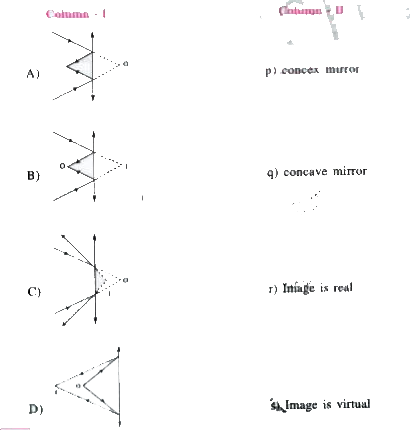Column-I contains the path traced by light rays and the positions of object and image, with a reflecting spherical mirror. Choose the possible options for type of mirror and the nature of image rom Column-II to each case in Column- I

The correct Answer is:A, B, C, D
Topper's Solved these Questions
- GEOMETRICAL OPTICSBOOK - AAKASH SERIESCHAPTER - GEOMETRICAL OPTICSEXERCISE - PRACTICE SHEET (EXERICSE-II (LEVEL-II (ADVANCED) INTEGER TYPE QUESTIONS))
5 Videos
- GEOMETRICAL OPTICSBOOK - AAKASH SERIESCHAPTER - GEOMETRICAL OPTICSEXERCISE - PRACTICE SHEET (EXERICSE-III (LEVEL-I (MAIN) )
6 Videos
- GEOMETRICAL OPTICSBOOK - AAKASH SERIESCHAPTER - GEOMETRICAL OPTICSEXERCISE - PRACTICE SHEET (EXERICSE-II (LEVEL-II (ADVANCED) LINKED COMPREHENSION TYPE QUESTIONS))
6 Videos
- ELEMENTS OF VECTORSBOOK - AAKASH SERIESCHAPTER - ELEMENTS OF VECTORSEXERCISE - QUESTIONS FOR DESCRIPTIVE ANSWERS
9 Videos
- LAWS OF MOTIONBOOK - AAKASH SERIESCHAPTER - LAWS OF MOTIONEXERCISE - PRACTICE EXERCISE
98 Videos
Similar Questions
Column I contains the path traced by light rays abnd the positions of object and image, with a reflecting spherical mirror. Choose the possible for type of mirror and the nature of image rom column II to each case in column -I

View SolutionColumn -I contains a list of mirror and position of object . Match this with Column-II describing the nature of image.
_S01_068_Q01.png)
View Solution
Knowledge Check
Match the reactions in Column I with nature of the reactions/type of the products in Column II
 AABCD21,434BABCD1,431,21CABCD2314DABCD342,31
AABCD21,434BABCD1,431,21CABCD2314DABCD342,31Match the reactions in Column I with nature of the reactions / type of the products in Column II
AColumn IColumn II(A)O−2→O2+O2−2(P)Redox reactionBColumn IColumn II(B)CrO2−4+H+→(Q)One of the products has trigonal planar structureCColumn IColumn II(C)MnO−4+NO_2+H+→(R)dimeric bridged tetrahedral metal ionDColumn IColumn II(D)NO−3+H2SO4+Fe2+→(S) disproportionation
Plane mirrors are arranged parallel to each other as shown in column-I and the number of images formed by the combination is in column- II
_E01_090_S01.png)
View SolutionPlane mirrors are arranged parallel to each other as shown in column-I and the number of images formed by the combination is in column- II
_E01_090_S01.png)
View SolutionMatch the object natures in column I with the natures of their images formed by a plane mirror in column II.

View SolutionIn case of a convex mirror, if object is moved away from the mirror, how do the position, size and nature of image change?
View SolutionAn object is kept in front of a spherical mirror and it is found that the image of height double to that of the object is formed by the mirror. If radius of curvature of spherical mirror is 40 cm then what are the possible positions of object in front of the mirror and which type of mirror is this?
View SolutionIf the image formed by a spherical mirror for all positions of the object placed in front of it is always erect and diminished, what type of mirror is it ?
View Solution
